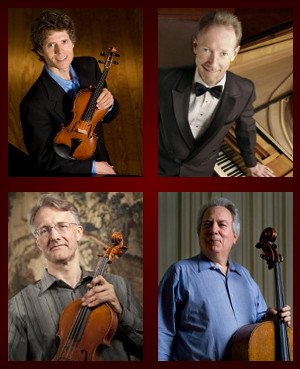The intention of the members of the Ciompi Quartet Presents program, Mozart’s Playground, was to sample works by composers who influenced the young Wolfgang Amadeus Mozart (1756-91) and to perform them on HIP (Historically Informed Performances) replicas of period instruments. The first half of the concert featured works for piano and violin by two of the sons of J. S Bach and the young Mozart. They were performed by Andrew Willis on a replica 18th century Viennese fortepiano after Anton Walter and by Eric Pritchard on a baroque violin.
Before the concert began, Pritchard announced that the E string on his baroque violin had “ba-roque!” Instead of tediously restringing, etc., he opted to use his modern violin tuned down to A 430. High humidity made intonation challenging while the higher tension of strings on the modern violin meant it tended to dominate more than the delicate gut-stringed instrument would have done.
C. P. E. Bach (1714-88), the second surviving son of J.S. Bach and Maria Barbara Bach, was the most influential of his sons in Europe. His works reflect the transition from the complex baroque style of his father to the less elaborate early classical style. C.P.E.’s music is highly personal, known as empfindsamer Stil or “sensitive style,” that is very expressive and frequently turbulent. The latter is especially true of his “Hamburg Symphonies.” His Sonata in D minor for keyboard and violin, Wq. 72, H. 503 is in three movements: Adagio ma non troppo, Allegro, and Allegro. The first movement is dominated by melancholy melodies while the two fast movements are lively and engaging. The violin part has an accompanying role, often taking up the fortepiano’s lead. While Willis and Pritchard played well, the modern violin’s sound dominated more than it ought.
The choice of Johann Christian Bach (1735-82) was especially apt for a program culminating with Mozart. J.C. Bach, the eleventh and youngest surviving son of J.S. Bach, known as the “London Bach,” heavily influenced the musical development of Mozart. Sonata for keyboard and violin, Op. 16, No.1 in D, W. B10 (1778/79) is in two movements: Allegro assai and Andante grazioso. The work opens with a rather martial air before exploring some delicate interplay between the instruments. The fortepiano very clearly presents melodies in the second movement before the violin takes them up. Willis’ playing of J.C. Bach’s imaginative keyboard part was delightful while Prichard’s balance blended better.
During one of the boy Mozart’s European tours, he met J.C. Bach and even sat on Bach’s knee as they played keyboard four hands! Mozart rewrote three of J.C. Bach’s clavier sonatas in 1765 as piano concertos with string accompaniment (K. 107). Pritchard said Sonata in E-flat for piano and violin, K. 26, was the most advanced of a set of six such trial pieces Mozart composed for the festival of the Prince of Orange at the Hague in March 1766. This sonata is in three movements: Allegro molto, Adagio poco andante, and Rondeaux: Allegro. The opening movement is very fast with both players scurrying. The middle movement carries surprising emotional depth and weight while the finale ends in high spirits. Willis and Prichard were superb sailing through its virtuosic demands.
Mozart’s magnificent Divertimento in E-flat, K. 563, provided a feast for music lovers to end the concert. To call K. 563 a “diverimento” is a massive understatement. This is a pioneering effort by the composer as he explored this unusual combination of strings. It is in six movements. Composed after his last three symphonies, he poured all of his musical maturity into the skeleton form of six movements of what had been quality background music for court parties. This is thought to be the first string trio by any composer and Mozart’s towers over all later such trios. Mozart uses double-stops at a few points to create a denser sound. He achieves a richer sound in the wonderful fourth variation Andante movement by introducing the theme in a double-octave, two-part harmony. Lead violinist Eric Pritchard was joined by two others from the Ciompi Quartet, violist Jonathan Bagg, and cellist Fred Raimi. Balances and intonation were superb and each player produced a marvelous palette of color and dynamics. Their interpretation and playing richly deserved the standing ovation from the sellout crowd in acoustically superb Kirby Horton Hall in the Sarah P. Duke Gardens.
The Ciompi Quartet summer series includes two more concerts. The July 7 concert, Light and Shadow, will be presented by Jonathan Bagg, and the August 12 concert, Three Bs in a Minor Key, will be presented by Fred Raimi. For details, visit the Duke Arts page on the series.












